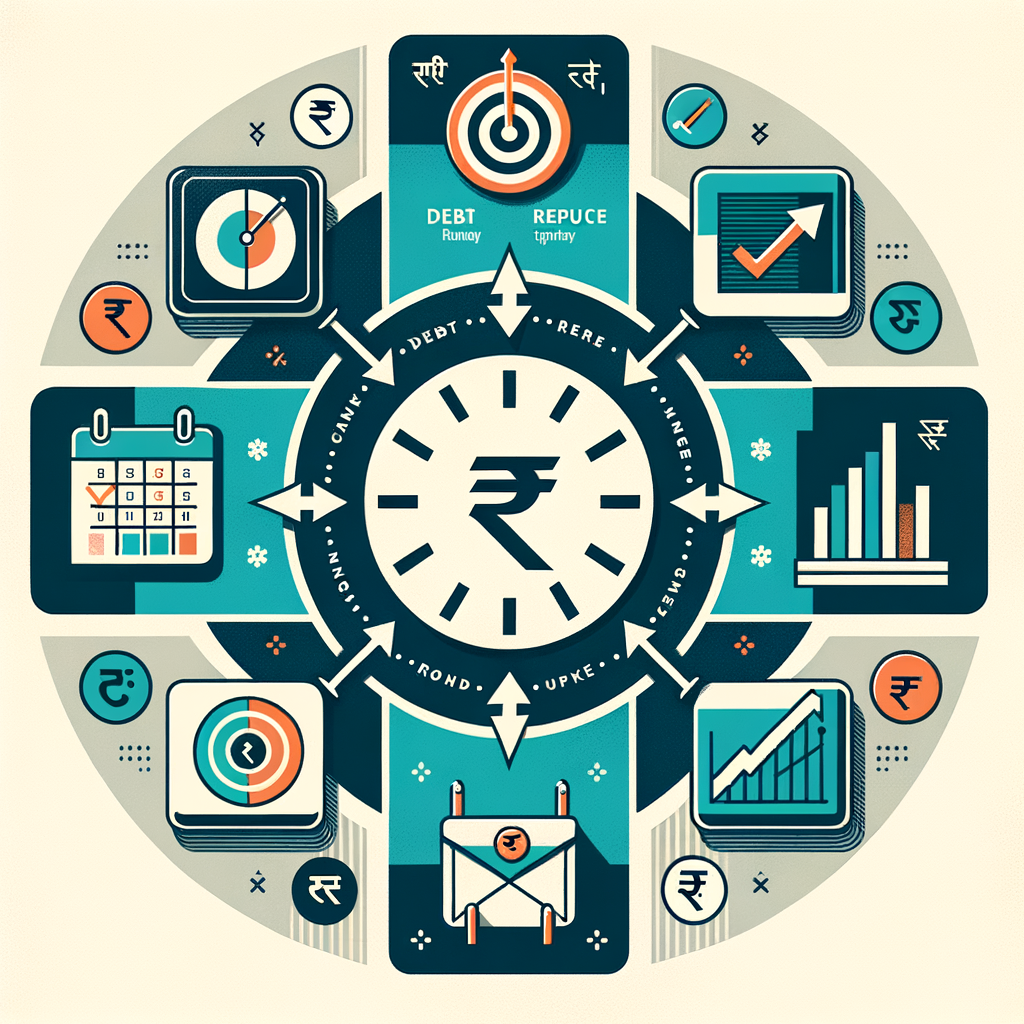Creating a Debt Reduction Timeline: Set and Meet Your Goals
The weight of debt can feel overwhelming, a constant source of stress for diligent salaried individuals and ambitious small business owners across India. It often feels like a cycle that’s hard to break, impacting everything from daily peace of mind to long-term aspirations. However, taking control of your financial future is not only possible but can be methodical and empowering with the right tool. A well-structured debt reduction timeline is your personal roadmap, transforming a chaotic financial situation into a clear, manageable plan. This guide will walk you through creating a personalized timeline, exploring proven strategies that will help you eliminate debt and finally meet your financial goals India. By focusing on clear steps and consistent action, you can turn your financial aspirations into reality and achieve your most important personal finance goals India.
Why a Debt Reduction Timeline is Your Roadmap to Financial Freedom
Embarking on a journey to become debt-free without a plan is like trying to navigate a new city without a map. You might eventually reach your destination, but the path will likely be inefficient, stressful, and filled with wrong turns. A debt reduction timeline provides the structure and clarity needed to navigate this journey effectively. It’s more than just a schedule; it’s a strategic document that brings immense psychological and financial benefits, empowering you to move forward with confidence and purpose. By committing to this plan, you transform vague hopes of financial freedom into a concrete project with a defined endpoint.
From Chaos to Clarity: Know Exactly Where You Stand
The first and most powerful step in solving any problem is understanding its full scope. A debt reduction timeline compels you to do just that. It forces you to gather all your outstanding liabilities—credit card bills, personal loans, business loans, and any other borrowings—into a single, consolidated view. This process of creating a comprehensive inventory immediately lifts the fog of uncertainty. You are no longer guessing or avoiding the numbers. Instead, you have a crystal-clear picture of your total debt, who you owe, the interest rates you are paying, and your minimum monthly obligations. This clarity is the foundation of control, allowing you to stop reacting to bills as they arrive and start proactively managing your financial health.
Motivation Through Milestones
Facing a large, multi-lakh debt figure can be incredibly demotivating. It seems like an insurmountable mountain. However, a timeline breaks this mountain down into a series of small, manageable hills. By setting debt repayment goals India, you create short-term milestones that are achievable and provide a sense of accomplishment along the way. Paying off your first, smallest debt, or even just hitting a monthly extra-payment target, delivers a powerful psychological boost. These small victories build momentum and reinforce positive financial habits, keeping you motivated for the long haul. Each milestone you cross off your list serves as tangible proof that your plan is working and that you are making real progress toward your ultimate goal of financial freedom.
Making Informed Financial Decisions
Once you have a clear timeline, your financial decision-making process becomes significantly simpler and more effective. You know precisely how much money needs to be allocated towards debt repayment each month to stay on track. This knowledge acts as a powerful filter for all your spending, saving, and investment choices. When considering a discretionary purchase, you can weigh it directly against its impact on your debt-free date. This framework helps curb impulsive spending and encourages you to find creative ways to free up more cash for your repayment goals. Ultimately, your timeline becomes a central pillar of your financial life, guiding you to make choices that align with your long-term vision of stability and prosperity.
Your Step-by-Step Guide to Creating a Debt Reduction Plan in India
Now that you understand the “why,” it’s time to dive into the “how.” Creating a debt reduction plan India is a systematic process that anyone can follow. By breaking it down into these four actionable steps, you can build a robust and realistic plan tailored to your unique financial situation.
Step 1: List and Organize All Your Debts
The very first action is to get a complete and honest view of everything you owe. Open a spreadsheet (like Google Sheets or Microsoft Excel) or simply use a notebook. Create a master list of all your debts, no matter how small they seem. Be thorough and meticulous. For each debt, you need to list the following critical details:
- Lender Name: Be specific (e.g., HDFC Bank Credit Card, SBI Personal Loan, Bajaj Finserv Consumer Loan, Local Business Loan).
- Outstanding Balance: The exact current amount you owe.
- Annual Interest Rate (APR): This is crucial, as it tells you how much each debt is costing you over time.
- Minimum Monthly Payment: The amount you are required to pay each month to avoid penalties.
Your completed list might look something like this:
| Lender Name | Outstanding Balance | Annual Interest Rate (APR) | Minimum Monthly Payment |
|---|---|---|---|
| ICICI Bank Credit Card | ₹75,000 | 28% | ₹3,000 |
| HDFC Personal Loan | ₹2,50,000 | 14% | ₹8,500 |
| Business Overdraft | ₹1,20,000 | 18% | ₹6,000 |
| Two-Wheeler Loan | ₹40,000 | 11% | ₹2,500 |
Step 2: Choose Your Debt Repayment Strategy
With all your debts laid out, you can now choose a strategy to tackle them. There are two primary, proven methods. The best one for you depends on your personality and what motivates you most: the psychological satisfaction of quick wins or the mathematical efficiency of saving the most money.
The Debt Snowball Method (For Quick Wins)
The Debt Snowball method focuses on building momentum. With this strategy, you continue to make the minimum payments on all your debts, but you throw every extra rupee you have at the debt with the smallest outstanding balance first, regardless of its interest rate. Once that smallest debt is paid off, you “snowball” the payment you were making on it (its minimum payment plus the extra amount) and add it to the payment for the next smallest debt. This approach provides rapid psychological victories, which is highly motivating. It’s an excellent debt reduction timeline for individuals who feel overwhelmed and need to see quick progress to stay committed to the plan.
The Debt Avalanche Method (To Save Money)
The Debt Avalanche method is mathematically the most efficient strategy. Here, you also make minimum payments on all debts, but you allocate all your extra funds towards the debt with the highest interest rate (APR). High-interest debt, like that from credit cards, costs you the most money over time. By eliminating it first, you minimize the total amount of interest you’ll pay throughout your journey. This is one of the most effective debt repayment strategies for salaried individuals and business owners who are driven by numbers and want to optimize their finances to save as much money as possible in the long run.
Step 3: Set Your Timeline and SMART Goals
Once you have your list and have chosen a strategy, it’s time to build your debt management timeline India. The most effective way to do this is by setting SMART goals for each debt you plan to tackle. SMART stands for Specific, Measurable, Achievable, Relevant, and Time-bound. This framework transforms a vague wish into a concrete action plan.
- S (Specific): Instead of “I will pay off debt,” your goal should be “I will pay off my ₹75,000 ICICI Bank Credit Card debt.”
- M (Measurable): “I will pay an extra ₹7,500 towards this credit card each month, in addition to the minimum payment.”
- A (Achievable): Look at your monthly budget. Can you realistically afford to pay an extra ₹7,500? If not, adjust the amount to something that is challenging but sustainable.
- R (Relevant): Connect this to your bigger financial picture. “Clearing this high-interest debt is relevant to my goal of becoming debt-free so I can start saving for a down payment on a house.”
- T (Time-bound): “Based on my extra payments, I will clear this credit card debt completely in 10 months.”
Apply this framework to each debt on your list, starting with your priority debt based on your chosen strategy (Snowball or Avalanche). This will create a clear and motivating timeline.
Step 4: Automate and Track Your Progress
Consistency is the key to success. The best way to ensure you stick to your plan is to automate it. Set up automatic payments from your bank account for the minimum amount due on every single one of your debts. This prevents you from ever missing a payment and incurring late fees. Then, for the debt you are currently targeting, set up an additional automatic transfer for the extra amount you’ve committed to paying. Automation removes the need for willpower and ensures you are consistently working towards your goal. Finally, schedule a monthly or quarterly “money date” with yourself to review your spreadsheet, track your progress, and celebrate your milestones. This also allows you to make adjustments if your income or expenses change.
Proven Debt Reduction Strategies India to Accelerate Your Timeline
Creating your timeline is a massive step forward, but you can speed up your journey to financial freedom even further. By implementing a few additional debt reduction strategies India, you can find more money to throw at your debt and reach your goal sooner than planned.
Increase Your Income Stream
The fastest way to pay off debt is to increase the amount of money you can allocate to it. For both salaried employees and business owners, there are numerous avenues to boost your income.
- For Salaried Individuals: Consider leveraging your skills for freelance work on platforms like Upwork or Fiverr. You could also explore part-time tutoring, content writing, or consulting in your field. Another powerful strategy is to focus on upskilling through online courses or certifications, which can position you for a promotion or a higher-paying job.
- For Small Business Owners: Look for opportunities to increase your business’s cash flow. This could involve introducing a new, high-demand service or product, running a limited-time promotion to attract new customers, or optimizing your pricing strategy to improve profit margins. Every extra rupee earned can be directed towards accelerating your debt repayment. Properly Managing Cash Flow Effectively During Tax Season can also free up significant funds.
Optimize Your Budget and Cut Expenses
Finding more money in your existing budget is just as effective as earning more. This requires a close look at where your money is going each month. Use a budgeting app like Walnut or Money Manager, or simply track your expenses in a notebook for a month. You will likely be surprised by where your money is being spent. Learning about Effective Budgeting Techniques to Reduce and Eliminate Debt can help you identify these areas. In the Indian context, common areas for potential savings include:
- Reducing the frequency of ordering food through apps like Zomato and Swiggy.
- Opting for more cost-effective entertainment options over expensive outings.
- Planning for major festival spending (like Diwali or Eid) well in advance to avoid last-minute debt.
- Reviewing and renegotiating recurring subscriptions and bills (e.g., mobile plans, streaming services).
Consider Debt Consolidation or a Balance Transfer
If you are juggling multiple high-interest debts, such as several credit cards or personal loans, consolidation might be a viable option.
- Debt Consolidation: This involves taking out a single new, lower-interest personal loan to pay off all your other outstanding debts. This simplifies your finances into one single EMI and can significantly reduce the total interest you pay. For a deeper understanding, review The Ultimate Guide to Debt Consolidation Loans.
- Credit Card Balance Transfer: Some banks in India offer promotional periods (e.g., 3-6 months) with 0% or very low interest rates if you transfer the balance from another bank’s credit card.
Caution: While these can be powerful tools, proceed with care. Debt consolidation loans may come with processing fees, and you need a good credit score to qualify for a favorable interest rate. A balance transfer is only effective if you can pay off the entire transferred amount before the promotional period ends, after which the interest rate can become very high. Always read the terms and conditions carefully before proceeding.
Conclusion
The journey out of debt begins with a single, decisive step: creating a plan. By meticulously listing your debts, choosing a focused repayment strategy like the Snowball or Avalanche method, setting SMART goals, and building a clear debt reduction timeline, you transform anxiety into action. This structured plan is the most reliable and empowering way to dismantle your debt piece by piece and pave the way to lasting financial freedom. Remember, the goal is not just to pay off what you owe, but to build healthier financial habits that will help you achieve your most important personal finance goals India for years to come.
Feeling overwhelmed with managing your business or personal finances? TaxRobo’s experts can help with accounting, financial planning, and more, so you can focus on your debt-free journey. Contact us today for a consultation.
Frequently Asked Questions (FAQs)
1. How long should my timeline for reducing debt in India be?
There is no one-size-fits-all answer. The ideal duration for your timeline for reducing debt in India depends entirely on your personal circumstances, including your total debt amount, your monthly income, your essential expenses, and how aggressively you can afford to make extra payments. For some, it might be a focused two-year plan, while for others with larger debts, it could be five years or more. The most important factor is creating a realistic timeline that you can stick to consistently without burning out.
2. What are the best debt repayment strategies for salaried individuals in India?
Both the Debt Snowball and Debt Avalanche methods are excellent choices. The best one depends on your personality. The Debt Avalanche method is often considered one of the most efficient debt repayment strategies for salaried individuals because it saves the most money on interest by targeting high-APR debts (like credit cards and some personal loans) first. However, if staying motivated is a challenge, the Debt Snowball method’s quick wins from paying off smaller loans first can provide the psychological encouragement needed to stay on track.
3. Can I adjust my debt reduction timeline?
Absolutely. Your debt reduction timeline is a living document, not something set in stone. Life is unpredictable. If you receive an annual bonus, a salary increase, or a financial windfall, you can and should use it to accelerate your timeline by making a lump-sum payment. Conversely, if you face an unexpected major expense like a medical emergency, you may need to temporarily pause your extra payments and adjust your timeline. The key is to remain flexible, review your plan periodically, and get back on track as soon as you can without giving up on the goal.
4. What free tools can help me create a debt reduction plan in India?
You don’t need expensive software to get started. Simple and powerful tools are readily available. You can create a comprehensive debt and budget tracker using Google Sheets or Microsoft Excel. For tracking day-to-day expenses and understanding your spending habits, many excellent Indian budgeting apps like Walnut, Money Manager, or INDmoney can be very helpful. Furthermore, most banking mobile apps now have built-in expense tracking features that can help you categorize your spending and identify areas for savings.



